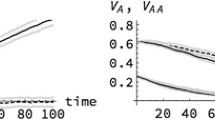Summary
Bias in the estimation of gene number from a population of finite size will be reduced when the number of generations and the selection differential in the primary selection program are increased. A procedure to minimize bias due to dominance is proposed. Bias due to linkage disequilibrium is decreased by long generations of selection and small change of linkage disequilibrium. Bias due to inequality of gene effects was studied assuming that gene effects follow a half normal distribution. The epistatic bias arising from multiplicative gene effects disappears when the logarithms of the original measurements are considered even though the gene number estimate is unsatisfactory without transformation.
Similar content being viewed by others
Literature
Castle, W.E.: An improved method of estimating the number of genetic factors concerned in cases of blending inheritance. Science 54, 223 (1921)
Comstock, R.E.: Number of genes affecting growth in mice. Genetics Lectures (Oregon State University) 1, 137–148 (1969)
Comstock, R.E.; Robinson, H.F.: The components of genetic variance in populations of biparental progenies and their use in estimating the average degree of dominance. Biometrics 4, 254–266 (1948)
Comstock, R.E.; Robinson, H.F.: Estimation of average dominance of genes. In: Heterosis, pp. 494–516. Ames, Iowa: Iowa State University Press 1952
Enfield, F.D.; Comstock, R.E.; Goodwill, R.; Braskerud, O.: Selection for pupa weight in Tribolium castaneum. II. Linkage and level of dominance. Genetics 62, 849–857 (1969)
Falconer, D.S.: Introduction to quantitative genetics. The Ronald Press Company 1960
Horner, T.W.; Comstock, R.E.; Robinson, H.F.: Nonallelic gene interactions and the interpretation of quantitative genetic data. North Carolina Agr. Exp. Sta. Tech. Bull. 118 (1955)
Mather, K.: Biometrical genetics. Dover Publications, Inc. 1949
Moll, R.H.; Lindsay, M.F.; Robinson, H.F.: Estimates of genetic variances and level of dominance in maize. Genetics 49, 411–423 (1964)
NaPuket, S.R.: Estimation of number of genes controlling quantitative traits. Ph.D. Thesis. Univ. of Minn. (1967)
Park, Y.C.: Variance of gene frequencies from recurrent selection in finite populations. Genetics 85, 339–346 (1977)
Park, Y.C.: Theory for the number of genes affecting quantitative characters I. Estimation of and variance of the estimate of gene number for quantitative traits controlled by additive genes having equal effects. Theor. Appl. Genet. 50, 153–161 (1977)
Roberts, R.C.: The limits to artificial selection for body weight in the mouse. I. The limits attained in earlier experiments. Genet. Res. 8, 347–360 (1966)
Robertson, A.: The nature of quantitative genetic variation. In: Heritage from Mendel (ed. Brink, R.A.), pp. 265–280. University of Wisconsin Press 1967
Sentz, J.C.; Robinson, H.F.; Comstock, R.E.: Relations between heterozygosis and performance in maize. Agron J. 46, 514–520 (1954)
Thoday, J.M.: Location of polygenes. Nature 191, 368–370 (1961)
Wehrhahn, C.; Allard, R.W.: The detection and measurement of the effects of individual genes involved in the inheritance of a quantitative character in wheat. Genetics 51, 109–119 (1965)
Wright, S.: The results of crosses between inbred strains of guinea pigs differing in number of digits. Genetics 19, 537–551 (1934)
Wright, S.: The analysis of variance and the correlations between relatives with respect to deviations from an optimum. J. Genetics 30, 243–256 (1935)
Wright, S.: The genetics of quantitative variability. In: Quantitative inheritance (eds. Reeve, E.C.R.; Waddington, C.H.) London: H.M.S.O. 1952
Wright, S.: Evolution and the genetics of populations. Genetics and Biometric Foundations. Vol. 1. The University of Chicago Press 1968
Author information
Authors and Affiliations
Additional information
Communicated by R.W. Allard
From a thesis submitted by the author in partial fulfillment of the requirements for the Ph.D. degree. Received March, 1975. Work supported by Public Health Service Grant GM 16074, by the Minnesota Agricultural Experiment Station and by National Institutes of Environmental Health Sciences Grant 5 T32 ES07011-02.
Former Research Assistant, Genetics and Cell Biology, University of Minnesota; currently Postdoctoral Fellow in Environmental Health Measurement and Statistics.
Rights and permissions
About this article
Cite this article
Park, Y.C. Theory for the number of genes affecting quantitative characters. Theoret. Appl. Genetics 50, 163–172 (1977). https://doi.org/10.1007/BF00277737
Received:
Issue Date:
DOI: https://doi.org/10.1007/BF00277737




